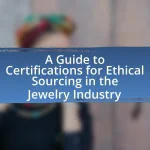Seasonal jewelry care involves adjusting maintenance and storage practices based on seasonal changes to protect jewelry from environmental factors such as humidity, heat, and cold. This article outlines the importance of adapting jewelry care throughout the year, detailing how different seasons affect materials and the risks of neglecting proper care. It provides specific cleaning and storage tips for each season, emphasizing the need for regular inspections and the use of appropriate tools and products to maintain jewelry integrity. Additionally, the article highlights common mistakes to avoid and offers practical advice for effective seasonal jewelry maintenance.

What is Seasonal Jewelry Care?
Seasonal jewelry care refers to the practice of adjusting the maintenance and storage of jewelry according to the changing seasons. This approach is essential because different weather conditions can affect the materials and settings of jewelry, such as exposure to humidity, heat, or cold. For instance, during summer, increased perspiration can lead to tarnishing of metals, while winter may require extra care to prevent damage from dry air. Proper seasonal care includes cleaning, inspecting for wear, and storing jewelry in appropriate conditions to prolong its lifespan and maintain its appearance.
Why is it important to adapt jewelry care throughout the year?
Adapting jewelry care throughout the year is important because seasonal changes can affect the materials and settings of jewelry. For instance, exposure to humidity in summer can lead to tarnishing of metals, while cold winter air can cause brittle gemstones to crack. Regularly adjusting care routines, such as cleaning and storing jewelry according to seasonal conditions, helps maintain the integrity and appearance of the pieces. This proactive approach prevents damage and prolongs the lifespan of jewelry, ensuring it remains in optimal condition regardless of environmental factors.
How do seasonal changes affect jewelry materials?
Seasonal changes significantly affect jewelry materials by influencing their durability, appearance, and maintenance needs. For instance, exposure to humidity in summer can cause tarnishing in metals like silver, while cold winter temperatures can make certain gemstones more brittle. Additionally, seasonal activities, such as swimming in chlorinated pools during summer, can damage certain materials like pearls and soft stones. Research indicates that specific care routines, such as storing jewelry in climate-controlled environments and using protective coatings, can mitigate these seasonal effects, ensuring the longevity and aesthetic appeal of jewelry.
What are the risks of neglecting seasonal jewelry care?
Neglecting seasonal jewelry care can lead to significant risks, including tarnishing, damage, and loss of value. Jewelry exposed to varying temperatures and humidity levels can suffer from corrosion and discoloration, particularly metals like silver and gold. For instance, neglecting to clean and store jewelry properly during humid summer months can result in tarnish buildup, which may require professional cleaning to restore. Additionally, gemstones can become loose or scratched if not stored correctly, leading to potential loss or costly repairs. Regular maintenance tailored to seasonal conditions is essential to preserve the integrity and appearance of jewelry, ensuring it remains in optimal condition and retains its value over time.
What are the general principles of jewelry care?
The general principles of jewelry care include regular cleaning, proper storage, and avoiding exposure to harsh chemicals. Regular cleaning helps maintain the shine and integrity of the jewelry, while proper storage prevents scratches and tangling. Avoiding harsh chemicals, such as those found in household cleaners, protects the materials from damage. These practices are essential for preserving the quality and longevity of jewelry, ensuring it remains in good condition over time.
How can cleaning methods vary by season?
Cleaning methods for jewelry can vary by season due to changes in environmental conditions and usage patterns. In spring and summer, increased exposure to sweat, sunscreen, and chlorine from swimming can necessitate more frequent cleaning with gentle solutions to remove residues. In contrast, fall and winter may require less frequent cleaning, but more attention to moisture and tarnish prevention, especially for silver jewelry, as colder temperatures can lead to oxidation. Seasonal changes in humidity and temperature also influence the effectiveness of cleaning agents, making it essential to adapt methods accordingly.
What storage practices should be followed year-round?
Year-round storage practices for jewelry include keeping items in a cool, dry place, using anti-tarnish pouches, and storing pieces separately to prevent scratching. A cool, dry environment minimizes moisture and temperature fluctuations that can damage jewelry. Anti-tarnish pouches absorb humidity and prevent tarnishing, particularly for silver items. Storing jewelry separately, such as in individual compartments or soft pouches, protects against scratches and tangling, preserving the integrity of each piece. These practices are essential for maintaining the quality and appearance of jewelry throughout the year.

How should jewelry care be adapted for each season?
Jewelry care should be adapted for each season by considering environmental factors that can affect the materials. In spring, clean jewelry regularly to remove dirt and moisture from increased humidity. In summer, avoid exposing jewelry to chlorine and saltwater, which can cause tarnishing and damage. During autumn, store jewelry in a dry place to prevent moisture-related issues, and in winter, protect pieces from extreme cold and dry air that can lead to brittleness. These seasonal adjustments help maintain the integrity and appearance of jewelry, ensuring longevity and continued enjoyment.
What specific care tips are recommended for spring?
For spring, specific care tips for jewelry include cleaning pieces with a gentle soap solution to remove dirt and oils, storing items in a dry, cool place to prevent tarnishing, and checking for loose stones or clasps to ensure security. These practices help maintain the integrity and appearance of jewelry, as spring often brings increased humidity and outdoor activities that can affect jewelry condition. Regular maintenance, such as polishing with a soft cloth, can also enhance shine and longevity.
How does humidity impact jewelry maintenance in spring?
Humidity significantly affects jewelry maintenance in spring by increasing the risk of tarnishing and corrosion, particularly for metals like silver and copper. High humidity levels can lead to moisture accumulation, which accelerates the oxidation process on these metals. For instance, silver jewelry can tarnish within hours in humid conditions due to the reaction between moisture and sulfur compounds in the air. To mitigate these effects, it is advisable to store jewelry in airtight containers and use anti-tarnish strips. Regular cleaning with a soft cloth can also help maintain the jewelry’s appearance and prevent buildup from humidity.
What types of jewelry are best suited for spring wear?
Lightweight and colorful jewelry is best suited for spring wear. Spring often brings a sense of renewal and vibrancy, making pieces such as floral-themed earrings, pastel-colored bracelets, and delicate necklaces ideal choices. These types of jewelry complement the season’s fresh aesthetics and are often made from materials like lightweight metals, beads, and natural stones, which align with the lighter clothing typically worn in spring. Additionally, the use of bright colors and nature-inspired designs reflects the blooming flowers and greenery of the season, enhancing the overall spring wardrobe.
What unique considerations are there for summer jewelry care?
Summer jewelry care requires special attention due to increased exposure to heat, humidity, and chlorine. High temperatures can cause certain materials, like plastics and resins, to warp or discolor, while humidity can lead to tarnishing of metals. Additionally, exposure to chlorine in pools can damage gemstones and metals, leading to potential degradation. To protect jewelry, it is advisable to store pieces in a cool, dry place, avoid wearing them while swimming, and clean them regularly with appropriate solutions to maintain their luster and integrity.
How does sun exposure affect different jewelry materials?
Sun exposure can significantly affect various jewelry materials, leading to discoloration, degradation, or structural damage. For example, gemstones like amethyst and citrine can fade when exposed to prolonged sunlight, as ultraviolet rays can break down their chemical structure. Similarly, pearls can lose their luster and become dull due to UV exposure, which can damage their organic surface. Metals such as silver may tarnish more quickly when exposed to sunlight, as heat can accelerate the oxidation process. Additionally, synthetic materials like plastics can warp or discolor under UV light, compromising the integrity of the jewelry. These effects underscore the importance of protecting jewelry from direct sunlight to maintain its appearance and longevity.
What precautions should be taken when wearing jewelry at the beach?
When wearing jewelry at the beach, it is essential to avoid exposing it to saltwater, sand, and chlorine, as these elements can cause damage and tarnishing. Saltwater can corrode metals, while sand can scratch surfaces, and chlorine can weaken the integrity of certain materials. Additionally, removing jewelry before swimming or engaging in beach activities minimizes the risk of losing pieces in the water or sand. Proper storage in a protective case when not in use further safeguards jewelry from environmental damage.
How can fall affect jewelry care routines?
Fall can affect jewelry care routines by introducing environmental factors such as increased humidity and temperature fluctuations that can lead to tarnishing and damage. During this season, the presence of moisture in the air can accelerate oxidation processes, particularly for metals like silver and copper, which are prone to tarnishing. Additionally, wearing jewelry during outdoor activities common in fall, such as hiking or apple picking, increases the risk of exposure to dirt and debris, necessitating more frequent cleaning. Regular maintenance, including polishing and proper storage in anti-tarnish pouches, becomes essential to preserve the integrity and appearance of jewelry during this transitional season.
What cleaning methods are best for fall jewelry?
The best cleaning methods for fall jewelry include using a mild soap solution, a soft cloth, and a gentle brush for intricate designs. Mild soap mixed with warm water effectively removes dirt and oils without damaging the jewelry. A soft cloth can be used to wipe down pieces after soaking, while a gentle brush helps clean hard-to-reach areas, ensuring that the jewelry remains in good condition during the fall season when dust and debris can accumulate. Regular cleaning with these methods helps maintain the luster and integrity of the jewelry, preventing tarnish and buildup that can occur with seasonal changes.
How should jewelry be stored during the fall season?
Jewelry should be stored in a cool, dry place during the fall season to prevent moisture damage and tarnishing. The fall season often brings increased humidity, which can lead to corrosion and deterioration of metals and gemstones. To mitigate these risks, use anti-tarnish pouches or silica gel packets in your jewelry box to absorb excess moisture. Additionally, keeping jewelry in individual compartments or soft pouches can prevent scratching and tangling, ensuring that each piece remains in optimal condition.
What are the winter jewelry care essentials?
Winter jewelry care essentials include proper cleaning, storage, and protection from harsh weather conditions. During winter, jewelry can be exposed to moisture, salt, and cold temperatures, which can lead to tarnishing and damage. To mitigate these effects, it is crucial to clean jewelry regularly with a soft cloth to remove any moisture and dirt. Additionally, storing jewelry in a dry, airtight container can prevent oxidation and tarnishing. Using anti-tarnish pouches or cloths can further protect pieces from the elements. These practices are essential for maintaining the integrity and appearance of jewelry throughout the winter months.
How does cold weather impact jewelry durability?
Cold weather can negatively impact jewelry durability by causing materials to become brittle and more prone to damage. For instance, metals like gold and silver can contract in low temperatures, leading to potential cracks or breaks, especially in pieces with intricate designs or settings. Additionally, gemstones may experience thermal shock, which can result in chips or fractures. Research indicates that extreme cold can affect the structural integrity of various materials, emphasizing the importance of proper storage and care during winter months to maintain jewelry longevity.
What types of jewelry should be avoided in winter?
In winter, jewelry made from porous materials, such as pearls and certain gemstones, should be avoided. These materials can absorb moisture and become damaged due to the cold, dry air and exposure to harsh winter conditions. Additionally, delicate pieces with intricate designs or those that are not water-resistant can be prone to breakage or tarnishing when exposed to snow, ice, or salt used for de-icing roads. Therefore, opting for more durable metals like stainless steel or titanium, which are less affected by winter elements, is advisable.

What tools and products are essential for seasonal jewelry care?
Essential tools and products for seasonal jewelry care include a soft microfiber cloth, a gentle jewelry cleaner, an anti-tarnish cloth, and a storage solution like a jewelry box or organizer. The microfiber cloth effectively removes dirt and oils without scratching surfaces, while a gentle jewelry cleaner is formulated to safely clean various materials without causing damage. An anti-tarnish cloth helps prevent tarnishing, particularly for silver jewelry, by containing anti-tarnish agents. Finally, a jewelry box or organizer protects pieces from scratches and tangling, ensuring they remain in good condition throughout the year.
What cleaning products are safe for different types of jewelry?
For cleaning different types of jewelry, safe products include mild soap and water for gold and silver, a specialized jewelry cleaner for gemstones, and a soft cloth for pearls. Mild soap and water effectively remove dirt without damaging precious metals, while specialized cleaners are formulated to safely clean gemstones without causing scratches or dullness. Pearls require gentle cleaning with a soft cloth to avoid damage to their delicate surface. These methods are widely recommended by jewelers and cleaning experts to maintain the integrity and appearance of various jewelry types.
How can DIY cleaning solutions be made at home?
DIY cleaning solutions can be made at home using common household ingredients. For example, a simple all-purpose cleaner can be created by mixing equal parts of water and white vinegar in a spray bottle. This solution effectively cuts through grease and disinfects surfaces due to the acetic acid in vinegar, which has been shown to kill certain bacteria and viruses. Additionally, baking soda can be combined with water to form a paste for scrubbing surfaces, as it acts as a mild abrasive and deodorizer. These methods are not only cost-effective but also environmentally friendly, as they avoid harsh chemicals commonly found in commercial cleaners.
What tools are necessary for effective jewelry maintenance?
Effective jewelry maintenance requires a few essential tools: a soft cloth, a jewelry cleaning solution, a polishing cloth, a soft brush, and a storage box. The soft cloth is used for regular wiping to remove dirt and oils, while the jewelry cleaning solution helps to deep clean pieces without damaging them. The polishing cloth is specifically designed to restore shine to metals, and the soft brush is useful for cleaning intricate designs and settings. Finally, a storage box protects jewelry from scratches and tarnishing. These tools collectively ensure that jewelry remains in optimal condition throughout the year.
How can one identify signs of wear and tear in jewelry?
To identify signs of wear and tear in jewelry, examine the piece for visible damage such as scratches, dents, or discoloration. Regular inspection can reveal loose stones, broken clasps, or worn-out links, indicating that the jewelry may need repair or maintenance. Additionally, check for changes in the metal’s luster or the presence of tarnish, which can signify deterioration. These indicators are crucial for maintaining the integrity and appearance of jewelry over time.
What should be checked regularly to ensure jewelry longevity?
To ensure jewelry longevity, it is essential to regularly check for signs of wear, such as loose stones, damaged clasps, and tarnishing. Regular inspections help identify issues before they lead to more significant damage, preserving the integrity and appearance of the jewelry. For instance, a study by the Gemological Institute of America emphasizes that routine maintenance, including professional cleaning and checking settings, can extend the life of fine jewelry significantly.
How can minor repairs be handled at home?
Minor repairs at home can be handled by utilizing basic tools and materials to fix common issues. For instance, a loose clasp on a necklace can be tightened with pliers, while a broken earring post can be replaced using a simple earring repair kit. These kits often include essential components like replacement backs and adhesive, making it easier for individuals to perform repairs without professional help. According to a survey by the American Home Improvement Association, 70% of homeowners successfully complete minor repairs themselves, demonstrating that with the right tools and instructions, many repairs can be effectively managed at home.

What are the best practices for maintaining jewelry throughout the year?
The best practices for maintaining jewelry throughout the year include regular cleaning, proper storage, and avoiding exposure to harsh chemicals. Regular cleaning, ideally every few months, helps remove dirt and oils that can dull the appearance of jewelry. Using a soft cloth or a gentle jewelry cleaner specifically designed for the type of metal or gemstone is recommended. Proper storage in a dry, cool place, preferably in a lined jewelry box or individual pouches, prevents scratches and tangling. Additionally, avoiding exposure to harsh chemicals found in household cleaners, perfumes, and lotions protects the integrity of the jewelry. These practices are supported by jewelers who emphasize that consistent care prolongs the life and beauty of jewelry.
How can a seasonal jewelry care schedule be created?
A seasonal jewelry care schedule can be created by assessing the specific needs of different types of jewelry throughout the year. For instance, in spring, clean and inspect jewelry for any damage after winter storage; in summer, focus on protecting pieces from chlorine and saltwater exposure; in fall, check for loose stones and prepare for holiday wear; and in winter, store jewelry in a dry, cool place to prevent tarnishing. This structured approach ensures that jewelry remains in optimal condition, as regular maintenance can extend its lifespan and preserve its appearance.
What reminders can help keep jewelry care on track?
To keep jewelry care on track, establish a routine that includes regular cleaning, safe storage, and periodic professional inspections. Regular cleaning prevents tarnish and buildup, while safe storage in a dry, separate space avoids scratches and tangling. Periodic professional inspections ensure that settings are secure and stones are intact, which is crucial for maintaining the integrity of valuable pieces. These practices are supported by industry standards, which recommend cleaning jewelry every few months and having it professionally checked at least once a year to prolong its lifespan and maintain its appearance.
How can one incorporate jewelry care into daily routines?
To incorporate jewelry care into daily routines, individuals should establish a consistent practice of cleaning and inspecting their jewelry. This can be achieved by setting aside a few minutes each day to gently wipe pieces with a soft cloth to remove oils and dirt, which helps maintain their shine and integrity. Regularly checking for loose stones or signs of wear ensures that any necessary repairs can be addressed promptly, preventing further damage. Studies indicate that routine maintenance can extend the lifespan of jewelry significantly, as neglect can lead to costly repairs or loss.
What common mistakes should be avoided in jewelry care?
Common mistakes to avoid in jewelry care include exposing jewelry to harsh chemicals, neglecting regular cleaning, and improper storage. Exposing jewelry to substances like chlorine or bleach can damage metals and stones, leading to discoloration or deterioration. Regular cleaning is essential; neglecting this can result in buildup that dulls the appearance of the jewelry. Additionally, improper storage, such as tossing pieces together in a drawer, can cause scratches and tangling. These practices are widely recognized in jewelry care guidelines, emphasizing the importance of maintaining jewelry to preserve its beauty and longevity.
How can improper storage affect jewelry condition?
Improper storage can significantly deteriorate jewelry condition by exposing it to elements that cause tarnishing, scratching, or damage. For instance, storing jewelry in damp environments can lead to corrosion, particularly for metals like silver, which tarnishes when exposed to moisture and sulfur. Additionally, placing different pieces together without protective barriers can result in scratches and tangling, especially for delicate chains and gemstones. Research indicates that jewelry stored in fabric-lined boxes or anti-tarnish pouches maintains its condition better than those left in open or humid spaces, highlighting the importance of proper storage methods.
What are the consequences of using the wrong cleaning methods?
Using the wrong cleaning methods can lead to damage to jewelry, including discoloration, scratches, and structural weakening. For instance, using abrasive cleaners on delicate materials like pearls or soft gemstones can scratch their surfaces, while harsh chemicals can cause tarnishing or corrosion on metals such as silver and gold. Additionally, improper cleaning can result in the loosening of stones, leading to potential loss. Studies have shown that specific cleaning agents can degrade the integrity of certain materials, emphasizing the importance of using appropriate methods tailored to each type of jewelry.
What are some practical tips for effective seasonal jewelry care?
To ensure effective seasonal jewelry care, regularly clean and store jewelry properly according to the season. For winter, avoid exposing jewelry to harsh weather and moisture; clean pieces with a soft cloth after wearing. In spring, inspect for any damage and consider professional cleaning for intricate designs. During summer, protect jewelry from chlorine and saltwater by removing it before swimming; store in a cool, dry place. In fall, check for loose stones and ensure pieces are secure before wearing them with heavier fabrics. These practices help maintain the integrity and appearance of jewelry throughout the year.


